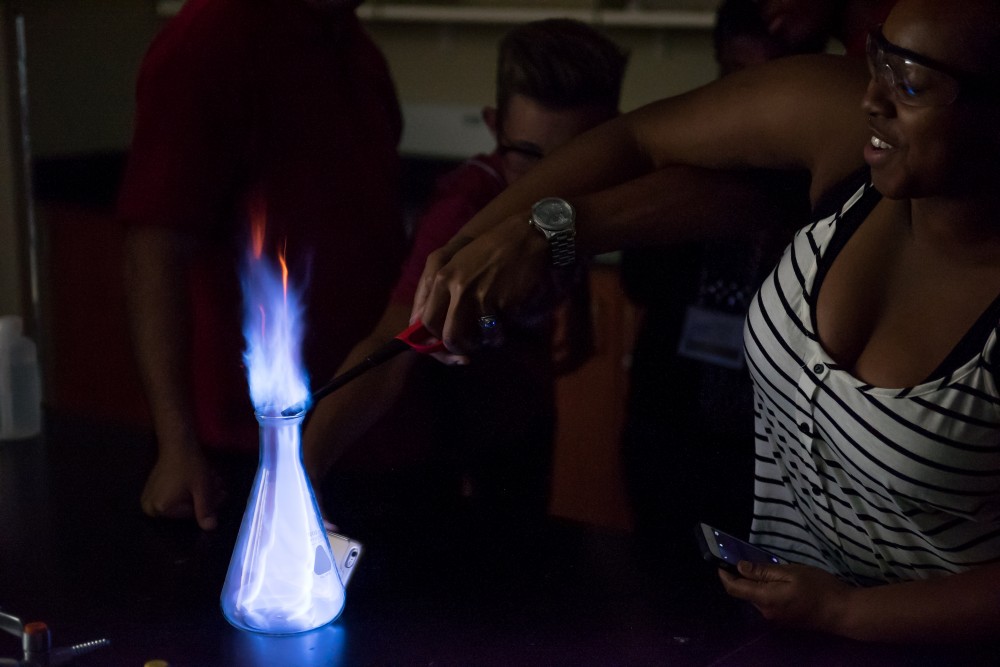Students from 10 Area Schools Attend UA STEM Entrepreneurship Academy Camp
- July 30th, 2019
- in STEM Entrepreneurship Academy
[envira-gallery id=”9410″]
Thirty-two campers from 10 high schools in the Tuscaloosa area got a hands-on introduction to science, technology, engineering, mathematics (STEM) and entrepreneurship during the Center for Community-Based Partnerships’ STEM Entrepreneurship Academy, held July 14–19 on The University of Alabama campus.
The purpose was to provide opportunities for high school students not only to engage in STEM/entrepreneurial activities but also to plan an entrepreneurial project to take back to their schools, interact with UA students and to explore campus facilities. Participating students were from Aliceville High, Amelia L. Johnson High, Central High, Francis Marion High, Greene County High, Greensboro High, Holt High, R.C. Hatch High, South Lamar High and Sumter Central High. Attendees were all sophomores or juniors nominated by their respective schools. Classes began July 15, with a session in math taught by Dr. Kabe Moen, associate professor of mathematics. He presented an overview of the discipline and careers for which math is key. To hold the campers’ attention, he introduced them to Liars Bingo, which helped them think outside the box and find the fun of math. Moen said, “STEM camp builds enthusiasm for science, helps students learn to work as a team and get along with one another, and to think about their future.” Later that day, campers attended a career fair, led by Career Center administrator Tariq Draine. At the fair they were able to ask questions and talk with UA students about potential college courses and extracurricular activities related to their major. During the Monday evening session, students met with Elizabeth Jernigan, STEM Entrepreneurship Academy facilitator and instructor of marketing in the Culverhouse College of Business. She introduced campers to research methods and began leading them in the process of planning a team project to address a problem or need in their school and community. On Tuesday, during a STEM biology session led by Dr. Michael R. McKain, assistant professor of biology and curator of the Herbarium, students learned about food sources and crop processes and how to isolate plant DNA. That afternoon, Dr. Marcus Ashford, associate professor of mechanical engineering, talked students through project design and taught them to build T-shirt cannons. During this session, students began converting their project from ideas to physical design, and plan ways to test their projects’ validity. Ashford said his goal was to introduce students to the hard process of research that leads “to the fun of success.” Students visited the Tuscaloosa Gateway on Tuesday evening, where they participated on several hands-on STEM activities. On Wednesday, Dr. Alexander Hainen, assistant professor of civil, construction and environmental engineering, described how traffic signals and security cameras are designed and assembled. He then led the campers on an observation of some of the duties of transportation and traffic engineers, for example by collecting traffic volume data at the intersection of Hackberry Lane and McCorvey Drive. The group later traveled to Jack Warner Parkway to measure the speed of passing cars using radar guns and to view live-streaming security camera video in the control room of the Tuscaloosa Regional Traffic Management Center. “Transportation and traffic engineering involves a lot of application of math, science and physics,” Hainen told the campers, adding that the field would be a promising career for them to consider. For their part, the campers showed great enthusiasm during the sessions, with several saying they would never feel the same driving through traffic signals. On Thursday morning, campers were taught computer science basics by Dr. Jeff Gray, UA professor of computer science, and were given the opportunity to use the Micro:bit, a computer coding device. That afternoon, they visited The Edge Entrepreneurship Institute, a business project incubator and accelerator in Tuscaloosa that focuses on growing and supporting entrepreneurs. Throughout their six-day camp, students were challenged to design a project that addresses a problem in their school or community using a hypothetical $2,000 seed grant. Under the guidance of counselors, students worked in groups and presented their proposals before teachers, parents and fellow campers during the closing program July 19. This year, for the first time, UA’s Division of Community Affairs provided financial support for selected projects to help students implement their projects in their schools and communities. Teams from Aliceville High School, Greensboro High School and Central High School were selected to receive funding totaling $1,750.
Central’s winning project would establish an after-high-school life preparedness club. “This camp opened my eyes to my future,” said Central High School 11th-grade student Amelia Knox. “The most challenging part was to develop the plan step by step. It’s a great opportunity for us to bring this project back to school.”
Uniontown’s R.C. Hatch High School 10th-grade student Tralisia Hunter wants to be a neurosurgeon. She said attending the camp strengthened her determination to follow through with her goals. Her favorite part of camp was the computer science activities. The mother of a Greensboro High School camp participant said, “To send my son away for a whole week was hard, but seeing him and his teammates present their project made me proud. He is growing, he is learning, and this is just amazing.” Andrea Ziegler, director for Community Education at CCBP, said, “The STEM Entrepreneurship Academy offered students the opportunity to apply their skills in the STEM disciplines to real-life situations and then carry that experience to the next level by developing a project to help their school and community.”

